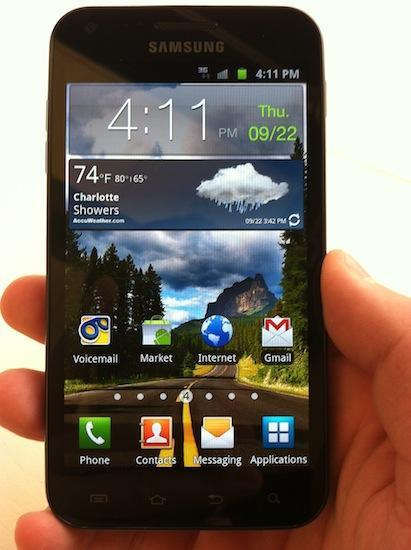
Samsung Galaxy S II, Epic 4G Touch. Samsung's first stateside Galaxy S II device is a mouthful, but like the name, it's packed with drool-worthy features that are great for Android die-hards and first-time users alike. Packing the same 1.2 GHz dual-core Exynos CPU, 8-megapixel camera that the international version has, Samsung takes a winning formula and makes it better with a 4.52-inch Super AMOLED display and larger 1,800 mAh battery.
It's available at Sprint for $199.99 with a two-year agreement, placing it in that competitive sub-$200 tier alongside the iPhone 4, Verizon's dual-core 3G handsets, and AT&T's top-tier Android devices. But it's coming in just before what is expected to be a very busy holiday season. Is Sprint's newest Android superphone worth two Benjamins and a two-year contract?
It may have a 4.52-inch Super AMOLED Plus display, but the Epic 4G Touch is deceptively small. At 9.6mm thin, it weighs 4.55 ounces, and is incredibly easy to throw into the pocket or purse. Epic 4G Touch is made entirely of plastic, and while contributes to the lightweight nature of the phone, it also gives it a cheap feeling in comparison to the metal-toting devices out there.
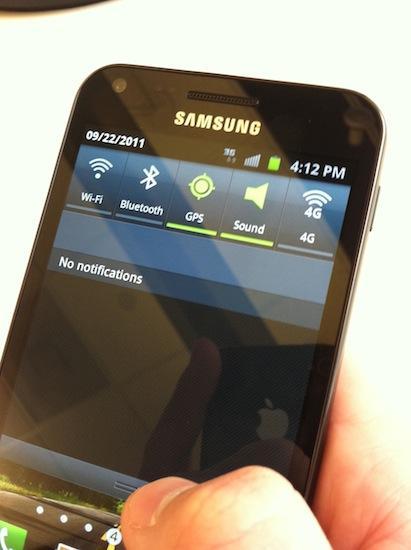
In the box, you'll get an AC adapter, USB cable, and instruction manuals. The left spine of the device houses a lanyard hole and a volume rocker, while the right spine contains the power button. The 3.5mm headphone jack is on the top, and the microUSB charging port is on the bottom. The Epic 4G Touch trades in the physical home button for four capacitive ones: menu, home, back, and search.
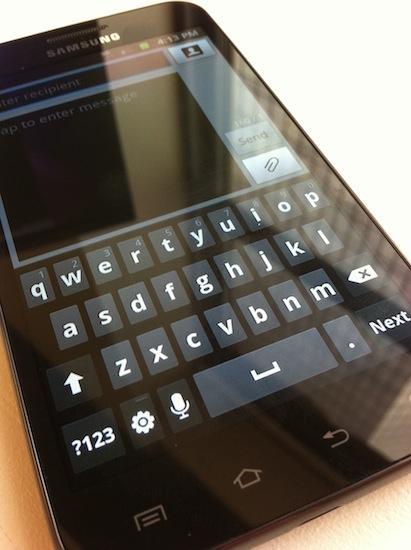
Watching Samsung's move from back-of-the-pack to frontrunner in the speed department has been interesting. The 1.2 GHz dual-core Exynos processor is lightning fast, and combined with software improvements, allows the Epic 4G Touch to snag scores between 3,300 and 3,500 in Quadrant Standard. I can honestly say that I've seen no lag since I started working with the unit - in fact, it the performance is often smooth to the point of unbelievable.
Like the international Galaxy S II, the Epic 4G Touch ships with Android 2.3 and Samsung's TouchWiz 4.0 user interface. Once cluttered and bulky, TouchWiz has seen drastic improvements this time around. It's a much more fluid experience, and Samsung has included nice features like the ability to customize the size of the widgets. It works incredibly well, and is finally a solid competitor to HTC's Sense UI and Motorola's interface.
Still images are impressive in most lighting situations, thanks to an 8-megapixel camera. The interface closely resembles the one from the Galaxy Tab 10.1, with editing options that include shooting modes, scene modes, exposure values, and more. While Epic 4G Touch offers 1080p HD video recording, the video quality was a bit choppy, and audio was a bit hard to hear at times.
Call quality is quite good on the Epic 4G Touch. The earpiece is nice and loud, and while the device gets a bit toasty at times (particularly around the display), it's easy to hold up to the ear for extended periods of time. Callers had no problems hearing me, and the sound quality was excellent on my end. I took the Epic 4G Touch to a known Sprint dead zone in the Charlotte area, and while each connection was littered with static and dropouts, the phone managed to hold them all.
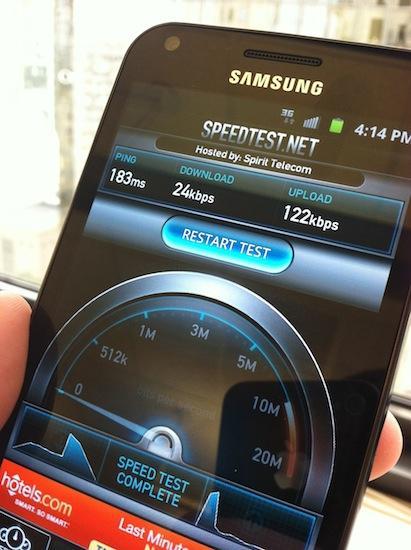
The giant downfall of the Epic 4G Touch has been Sprint's data speeds as of late. It's something I noticed in late spring and through the summer launches (EVO 3D and PHOTON, namely), and it has progressively gotten worse to the point where data is virtually unusable at times. I've tested data speeds in roughly 15-20 locations around Charlotte, and during "peak" hours (which I categorize as 8 AM to 7 PM), I've seen 3G download speeds between 0.01 Mbps and 0.40 Mbps.
My office, which is located in the center of the city, doesn't seem to fare much better. Small tasks like sending a tweet or updating the weather widget have taken two to six minutes at times, which, needless to say, is unacceptable. The issue doesn't seem tied to the Charlotte metro area either; I've noticed similar issues in the New York City and Orlando metro areas, and there are forum comments all over the Internet claiming similar issues in various metro areas across the United States.
4G (WiMAX) speeds are a bit better, though they're not what I would expect from a "next generation" technology. Depending on the time of day and location, I've scored download speeds between 0.48 Mbps and 2.07 Mbps. It certainly makes the device usable on a day-to-day basis, but pales in comparison to the 5-12 Mbps (and sometimes more) guaranteed on Verizon's 4G LTE network.
Sprint has been very receptive to the issues, and has taken the time to speak with me about the particulars. We're diagnosing now, so there's a possibility that things will improve - I'll keep the review updated accordingly.
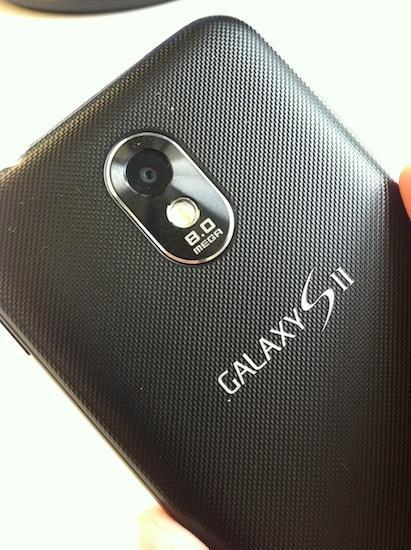
Samsung opted to pack an 1,800 mAh battery in the Epic 4G Touch due to the increased screen real estate, and in my tests, longevity was surprisingly good for an Android device. With moderate use that included some phone calls, a few app downloads, browsing the web, taking some pictures, and sending multiple text messages, I made it from morning to late evening with some power to spare. Turning on 4G will impact battery life, but not as much as you might expect, as the WiMAX radio does a pretty good job of switching to an inactive state when not in use.
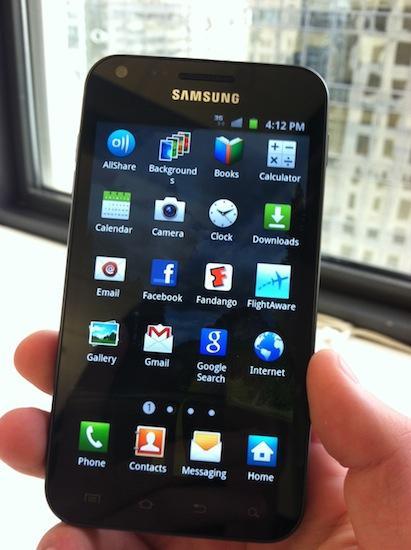
We've been waiting for the US variants for months, and like the international Galaxy S II, Samsung's Epic 4G Touch is the best Android phone available today. The dual-core processor and overall snappy performance will appeal to those seeking a high-end device, while the much-improved TouchWiz 4.0 UI is the perfect transition for someone coming from iOS or moving into the smartphone realm for the first time. While the increased screen size may be a point of contention for some buyers, Epic 4G Touch knocks it out of the park in every feature category, much like the HTC EVO 4G did when it launched.
Unfortunately, Sprint's poor data speeds as of late are a serious issue. We tend to forget everything that data has a hand in, and more importantly, how a poor data experience can impact the overall experience. From email to downloading apps to updating the little weather widget, a good data experience is crucial for today's always-on smartphones, and in the cities that I've traveled to as of late, Sprint's network isn't performing to par. That's not to say that they won't fix it in the future - or perhaps you're in an area where it works well - but it's a huge Achilles heel in an otherwise fantastic device.
What's Good: Dual-core processor is incredibly fast; 4.52-inch Super AMOLED Plus display is beautiful and a nice upgrade from the international version; 1,800 mAh battery allows for a full day of use; TouchWiz 4.0 UI is a huge improvement from past versions.
What's Bad: All-plastic design may not appeal to everyone; Sprint's poor data speeds as of late impact the performance of the phone's data services.
The Verdict: With a dual-core CPU, awesome display, clear camera, and good battery life, It's the best Android phone on the market (today), but it's hindered by painfully slow data speeds.